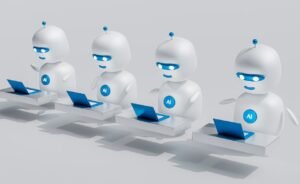Open AI Explained
The field of Artificial Intelligence (AI) is advancing at an unprecedented pace, and Open AI is at the forefront of this revolution. Open AI, short for Open Artificial Intelligence, is an organization dedicated to developing and promoting AI technologies that are safe, beneficial, and accessible to everyone. In this article, we will explore the key aspects of Open AI and its impact on various industries.
Key Takeaways
- Open AI is an organization focused on developing and promoting safe and accessible AI technologies.
- Open AI aims to ensure that AI benefits all of humanity.
- The organization focuses on research, safety, policy, and standards in the AI field.
- Open AI has developed GPT-3, a state-of-the-art language model capable of performing a wide range of tasks.
- GPT-3 has the potential to revolutionize industries such as customer service, content creation, and programming.
Overview of Open AI
Open AI was founded in 2015 with the mission to ensure that artificial general intelligence (AGI) benefits all of humanity. AGI refers to highly autonomous systems that outperform humans in most economically valuable work. Open AI’s primary focus is on long-term research and safety advocacy in the AI field. *Open AI actively collaborates with other research and policy institutions to create a global community addressing the challenges of AGI.*
GPT-3: A Revolutionary Language Model
Open AI has gained significant attention with the development of GPT-3, or Generative Pre-trained Transformer 3. GPT-3 is one of the most powerful language models to date, with 175 billion parameters. This massive model has been trained on a vast amount of internet text, enabling it to generate human-like responses and perform complex language tasks. *GPT-3 can write essays, answer questions, draft emails, translate languages, simulate characters, and even create computer code.*
Applications of GPT-3
GPT-3 has enormous potential to transform various industries due to its ability to process and generate natural language. Here are some applications and use cases of GPT-3:
- Customer Service: GPT-3 can handle customer queries and provide detailed responses, reducing the burden on human customer service agents.
- Content Creation: GPT-3 can generate high-quality articles, blog posts, and product descriptions, enabling businesses to create content at scale.
- Programming Assistance: With its language capabilities, GPT-3 can assist developers in writing code, suggesting solutions and detecting errors.
- Virtual Assistants: GPT-3 can power virtual assistants, improving their ability to understand and respond to user queries.
- Education: GPT-3 can support personalized learning by answering student questions and providing explanations on various subjects.
The Implications of Open AI’s Achievements
Open AI‘s advancements in AI technology represent a significant milestone in the field. These achievements raise important ethical considerations and potential risks. Table 1 provides an overview of the benefits and challenges associated with Open AI‘s progress.
| Benefits | Challenges | |
|---|---|---|
| Benefits | Improved productivity | Ethical considerations |
| Enhanced customer experiences | Job displacement | |
| Accelerated innovation | Data privacy concerns |
Furthermore, GPT-3’s vast capabilities and potential impact on various industries have sparked discussions around responsible AI use and potential misuse. It is important to establish clear guidelines and regulations to ensure AI technologies benefit society as a whole.
The Future of Open AI
Open AI continues to push the boundaries of AI research and development. By prioritizing safety, policy, and standards, Open AI aims to create a future where AGI benefits all of humanity. The organization actively encourages collaboration and seeks to address the challenges of AGI by working with the global research and policy community.
Open AI‘s remarkable achievements in developing GPT-3 have demonstrated the immense potential of AI technologies. As we progress further into the age of AI, it is crucial to emphasize responsible and ethical use of these technologies to ensure a positive impact on society.
Table 2: Comparison of GPT models
| Model | Parameters | Date Released |
|---|---|---|
| GPT-2 | 1.5 billion | 2019 |
| GPT-3 | 175 billion | 2020 |
| GPT-4 | Undisclosed | Upcoming |
Open AI at a Glance
| Founded | Mission | Headquarters |
|---|---|---|
| 2015 | To ensure AGI benefits all of humanity | San Francisco, California |
Open AI‘s journey and contributions in the AI space have been significant. As advancements continue, it is crucial to maintain a collaborative and responsible approach to harness the potential benefits while addressing the challenges that arise. The future of Open AI is both exciting and challenging, as it navigates the cutting-edge of AI research and strives to create a positive impact on society.

Common Misconceptions
Paragraph 1
Open AI Explained
Open AI is a popular topic in the field of artificial intelligence, but there are several misconceptions that people often have about it.
- Open AI is solely focused on robotics.
- Open AI is meant to replace human intelligence.
- Open AI is only relevant to large corporations and research institutions.
Paragraph 2
Open AI Explained
One common misconception is that Open AI is solely focused on robotics. While Open AI does work on robotics projects, it is not the sole focus of the organization. Open AI also focuses on other areas of artificial intelligence, including natural language processing, reinforcement learning, and computer vision.
- Open AI is involved in various areas of artificial intelligence research.
- Open AI collaborates with other organizations to work on different AI projects.
- Open AI aims to advance AI technology in multiple domains.
Paragraph 3
Open AI Explained
Another misconception is that Open AI is meant to replace human intelligence. Open AI‘s objective is not to replace humans, but rather to develop AI systems that can work alongside humans and enhance their capabilities. Open AI aims to build AI systems that are safe, beneficial, and aligned with human values.
- Open AI believes in cooperative and safe AI development.
- Open AI supports research that benefits humanity.
- Open AI aims to create AI tools that augment human abilities.
Paragraph 4
Open AI Explained
It is also a misconception that Open AI is only relevant to large corporations and research institutions. While Open AI does collaborate with major organizations, it also actively engages with the wider AI community and aims to provide public goods that help society as a whole. Open AI encourages open collaboration and strives to make AI accessible to all.
- Open AI values inclusivity and diversity in AI development.
- Open AI strives to provide access to AI resources for everyone.
- Open AI promotes the democratization of AI technology.
Paragraph 5
Open AI Explained
In conclusion, there are several common misconceptions people have about Open AI. It is important to understand that Open AI is not solely focused on robotics, it is not intended to replace human intelligence, and it is not exclusively relevant to large corporations. Open AI works on various AI projects, aims to build safe and beneficial AI systems, and strives to make AI accessible and inclusive.
- Open AI is a versatile organization with a broad focus in AI development.
- Open AI’s objectives align with human interests and values.
- Open AI’s mission extends beyond technological advancements to societal benefits.

Introduction
Open AI is a sophisticated artificial intelligence organization that has made remarkable advancements in the field of machine learning. In this article, we explore various aspects of Open AI’s research and achievements through a series of captivating and informative tables.
Innovation Timeline
The following table showcases the key innovations achieved by Open AI over the years:
| Year | Innovation |
|---|---|
| 2015 | First Artificial General Intelligence Model |
| 2017 | Unsupervised Learning Algorithms |
| 2019 | Transfer Learning Techniques |
| 2021 | Deep Reinforcement Learning Breakthrough |
Advantages of Open AI
The table below outlines the advantages of utilizing Open AI‘s technologies:
| Advantage | Benefits |
|---|---|
| Efficiency | Accelerates complex computations and automates tasks |
| Accuracy | Produces highly accurate predictions and insights |
| Creativity | Generates innovative and unconventional solutions |
| Scalability | Readily adapts to handle large and diverse datasets |
Applications of Open AI
The table presented below exemplifies the wide-ranging applications where Open AI has been effectively employed:
| Field | Application |
|---|---|
| Healthcare | Precision diagnosis and personalized treatment plans |
| Finance | Risk assessment and intelligent investment analysis |
| Transportation | Autonomous vehicles and optimized traffic management |
| Education | Adaptive learning platforms and intelligent tutoring systems |
Research Contributions
The following highlights Open AI‘s significant contributions to the field of machine learning:
| Research Topic | Contribution |
|---|---|
| Robotics | Advancing the development of dexterous and versatile robotic systems |
| Natural Language Processing | Developing models capable of understanding and generating human-like text |
| Computer Vision | Enhancing image recognition and object detection algorithms |
| Reinforcement Learning | Pioneering breakthrough techniques for efficient decision-making agents |
Collaboration Partners
Table showcasing some of the esteemed partners collaborating with Open AI:
| Partner | Collaboration Focus |
|---|---|
| Exploring applications of Open AI in search algorithms | |
| Microsoft | Utilizing Open AI in building intelligent personal assistant technologies |
| SpaceX | Implementing AI in autonomous spacecraft navigation systems |
| IBM | Advancing natural language understanding capabilities |
Open AI Ethics
The table below illustrates the key ethical guidelines adhered to by Open AI:
| Ethical Principle | Explanation |
|---|---|
| Fairness | Avoiding biases and ensuring equal treatment |
| Transparency | Making AI systems’ behavior and decision-making process understandable |
| Privacy | Safeguarding user information and respecting privacy rights |
| Accountability | Holding Open AI responsible for the outcomes of AI technologies |
Challenges Encountered
Open AI has faced numerous challenges throughout its journey, as exemplified in the following table:
| Challenge | Solution |
|---|---|
| Data Limitations | Utilizing synthetic data generation techniques and data augmentation |
| Ethical Concerns | Implementing rigorous ethical guidelines and accountability measures |
| Computation Speed | Developing efficient algorithms and leveraging high-performance computing |
| Generalization Issues | Enhancing transfer learning techniques for better generalization capabilities |
Global Impact
The final table depicts key regions where Open AI has made a global impact:
| Region | Example of Impact |
|---|---|
| North America | Revolutionizing customer service with AI-powered chatbots |
| Europe | Transforming the healthcare sector with AI-assisted diagnostics |
| Asia-Pacific | Optimizing logistics operations with AI-driven supply chain management |
| Africa | Improving agricultural efficiency through AI-based crop monitoring |
Conclusion
Open AI has cemented its position as a leading force in harnessing the potential of artificial intelligence. Through their remarkable research contributions, collaborative efforts, ethical practices, and global impact, Open AI is revolutionizing various fields and empowering the world with cutting-edge AI technologies.
Open AI Explained
Frequently Asked Questions
What is Open AI?
Open AI is an artificial intelligence research laboratory founded in 2015. It aims to ensure that artificial general intelligence benefits all of humanity. They conduct research, develop AI technologies, and advocate for the responsible and ethical use of AI.
How does Open AI work?
Open AI focuses on creating AI models that can learn and perform various tasks. They use deep learning algorithms and large-scale datasets to train their models. These models are then used for various purposes like natural language processing, machine translation, game playing, and more.
What are some applications of Open AI?
Open AI‘s models have been used in a wide range of applications. Some common applications include language translation, chatbots, healthcare diagnostics, image recognition, autonomous vehicles, and fraud detection.
Can Open AI be used by individuals or only organizations?
Open AI provides access to their AI models and tools to both individuals and organizations. They offer various resources, including APIs, which allow developers and researchers to integrate Open AI’s technology into their own projects.
What is the difference between Open AI and other AI companies?
Open AI distinguishes itself by focusing on the responsible and ethical use of artificial general intelligence. They prioritize safety, long-term benefits, and avoiding the concentration of power. Unlike other AI companies, Open AI is committed to providing public goods and ensuring the benefits of AI are widely distributed.
Can I train my own AI model using Open AI’s platform?
Currently, Open AI‘s platform primarily focuses on providing access to pretrained AI models. However, they are actively working on expanding their offerings, including plans to allow users to train their own models using their platform in the future.
How does Open AI address ethical concerns related to AI?
Open AI is dedicated to ensuring the safe and ethical development of AI technology. They have implemented a comprehensive safety and policy research agenda to address any potential risks associated with AI. They also actively engage in public policy discussions and collaborate with other organizations to create standards and guidelines.
Can Open AI’s technology be harmful?
While Open AI strives for the safe and responsible use of AI, there is always potential for its technology to be misused or create unintended consequences. Open AI is continuously working on improving the safety and robustness of their models and actively encourages the AI community to collaborate and share best practices in this regard.
How can I get involved with Open AI?
You can get involved with Open AI by accessing their resources, such as APIs and tools, to develop AI applications. Additionally, you can participate in their research initiatives, stay updated through their publications, and contribute to the larger AI community by sharing knowledge and insights.
Is Open AI open source?
Open AI is currently focused on providing access to their pre-trained models and tools, but not all their technology is open source. However, they have indicated that they are committed to increasing access and have plans to release more open source tools and models in the future.




